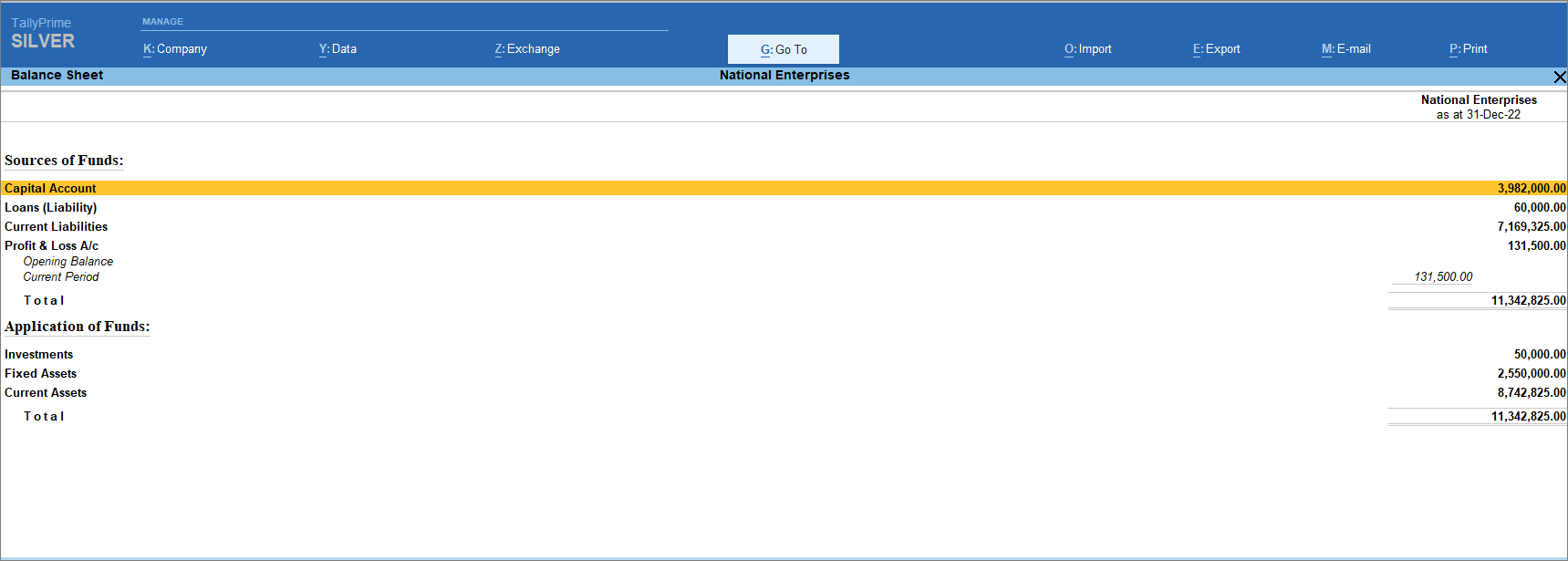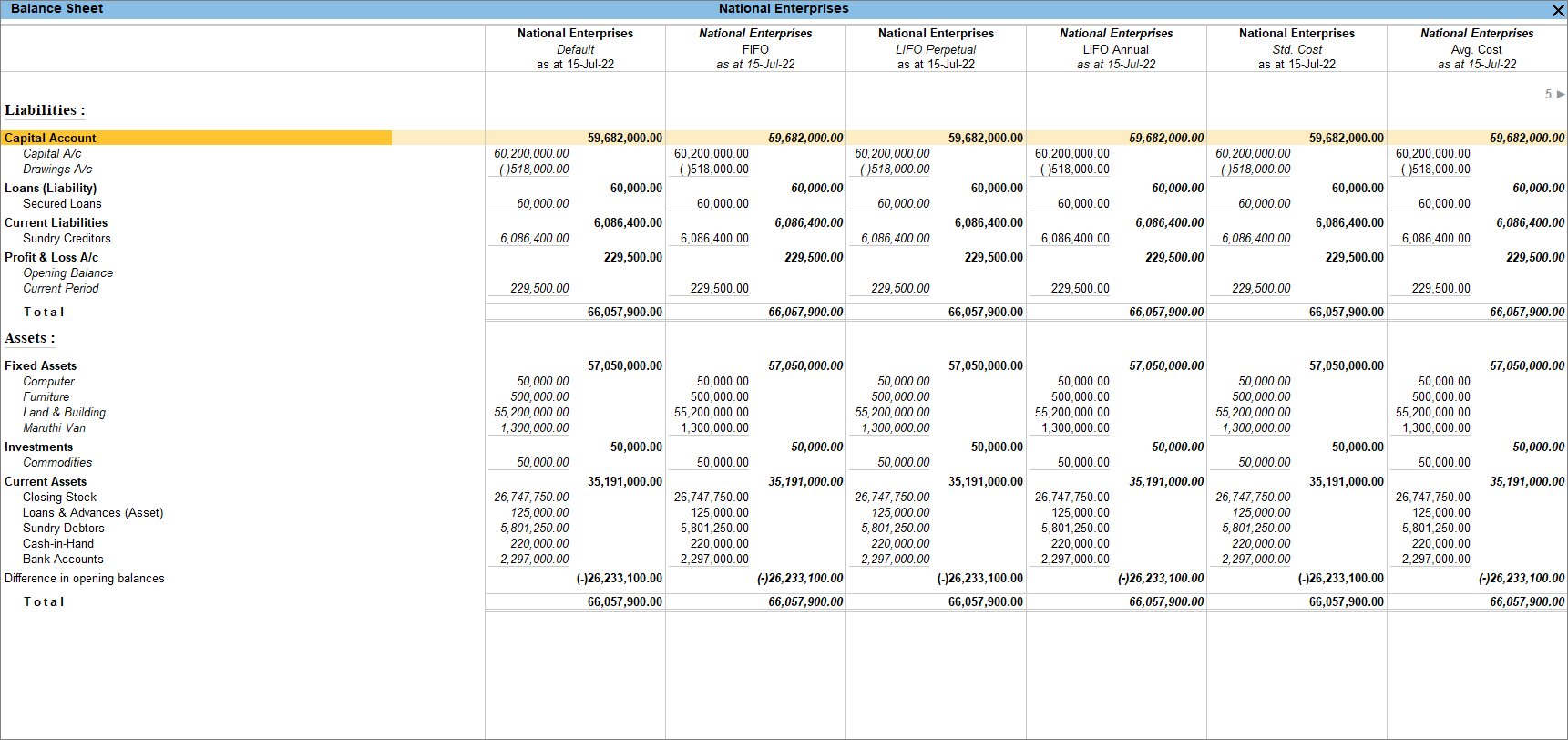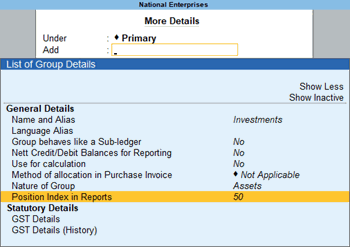Balance Sheet in TallyPrime
The Balance Sheet in TallyPrime provides you with a neat snapshot of your business. You can also expand the report for a comprehensive view of your assets such as cash in the bank, inventory, vehicles, equipment, buildings, and accounts receivable and liabilities such as taxes, loans, mortgages, and accounts payable. You can change the Order of Groups and view the Balance Sheet as per your requirement. You can also view the Balance Sheet in vertical format displaying the source and application of funds in a single column which makes it easier to compare the information. In TallyPrime, you can set your Closing Stock manually. In case you own a group company, you can view the consolidated Balance Sheet as well.
Balance Sheet is one of the primary financial statements that you can use to monitor the health of your business. It is a picture of the financial position of your company – what you own (assets) and what you owe (liabilities) – at a given time. The difference between what you own and what you owe determines the Net Worth (or Owner’s Equity) of your business.
The Balance Sheet helps you understand the performance of your business. The Balance Sheet also proves essential when your business is applying for a loan or investment. Thereby, external entities, such as investors, creditors, and banks, study the Balance Sheet to understand the financial health of a business.
You can also measure the growth of your business by comparing the Balance sheets of different years. In TallyPrime, you can use the Auto Column feature and select the current year and previous year Balance Sheet to measure the comparison. You can compare the Balance sheets of two or more of your companies to analyse which company is generating more profit. Thus, you will be able to take timely decisions for your company. For example, you can easily plan future projects and meet unexpected expenses. What’s more, you can also view the TallyPrime Balance Sheet in your browser!
View Balance Sheet
The Balance Sheet in TallyPrime helps you monitor the health of your business and also take timely decisions for its growth and betterment. By default, the Balance Sheet has a horizontal display.
- Press Alt+G (Go To) > type or select Balance Sheet > press Enter.
Alternatively, go to Gateway of Tally > Balance Sheet.
You can see the Liabilities for your company on the left and the Assets on the right.

A few of the critical uses of a Balance Sheet are as follows:
Stock Valuation
The default Valuation Method maintained in Balance Sheet is Default which is the Avg Cost method. However, you can change the valuation method and select the method that suits your business. You can press F8 (Valuation) or you can also select the Stock Valuation Method form Ctrl+B (Basis of Values). The most common valuation method used is FIFO where the goods which are bought first are sold first. If your business deals with physical goods or perishable goods, then you can follow the valuation method of FIFO. If you are a manufacturer or retailer, then you use the valuation method of LIFO which is Last In First Out. You can also decide which valuation method to be used for your business depending on the price of the products. If the goods bought earlier is having a higher price as compared to the goods bought later, you can decide which valuation method to be used. Apart from FIFO and LIFO methods, there are other valuation methods as well such as, At Zero Cost where you can see the quantity of your closing stock but without the purchase price, At Zero Price where the sale price is not visible, or Avg. Cost, Avg. Price and so on.
To learn more about Stock Valuation Method, click here.
Include Working Capital
Working Capital is the money that is used to cover the operating expenses of your business. It is the difference between Current Assets and Current Liabilities. You can analyse the financial condition of your business by Working Capital. The financial condition is considered to be stable if you can meet all your current liabilities with your current assets. You can view the Working Capital in the Balance Sheet from Ctrl+B (Basis of Values). Once you include Working Capital in the Balance Sheet, you can make informed decisions regarding your expenses and future investments.
Comparison using Auto Column
You can also perform a comparative study of your Balance Sheet for Monthly, Weekly, Fortnightly, and so on. The comparison helps you to get a better picture of how your business is performing and what is the growth rate of your business. Such comparison can also be done for Stock Valuation Method which helps you to identify which valuation method to be followed. You can do such a comparison by pressing Alt+N (Auto Column).
Apart from the above-mentioned configuration options, you can further configure your Balance Sheet from F12 (Configure).
- Exclude Accounts with zero Closing Balance: While displaying your company Balance Sheet to your investor, you may want to hide the accounts with zero balance and have no impact on the financial report. This helps to focus on the important accounts that reflect the financial condition of your business. You can remove such accounts with zero balance by pressing F12 (Configure) and enabling Exclude Accounts with zero Closing Balance.
- Show Loss also under Liabilities: In Balance Sheet the Loss is shown under Assets and similarly, by default, TallyPrime also displays the Loss under Assets. However, you can view the Loss under Liabilities as well. You can do so by pressing F12 (Configure) and enabling Show Loss also under Liabilities. This option is available only when the Balance Sheet display is horizontal.
- Method of showing Balance Sheet: The default view of the Balance Sheet shows Liabilities on the left side and Assets on the right. Depending on your requirement to view the Balance Sheet, TallyPrime has provided an option to alter the view and display Asset on the left side and Liabilities on the right. You can do so by pressing F12 (Configure) and selecting the required view from the Method of showing Balance Sheet.
To know more about the features of reports in TallyPrime, refer to Working with Reports.
View Balance Sheet for a Group Company
If you have a group company in TallyPrime, you can use the Balance Sheet to view the consolidated financial data and measure the overall performance of your business. You can also compare the Balance Sheet of your Group company along with its member companies.
- Press Alt+G (Go To) > type or select Balance Sheet.
Alternatively, Gateway of Tally > Balance Sheet. You can see the consolidated Balance Sheet. - Press Alt+F3 (Select Company), and load the group company.
- To compare the Balance Sheet of the member companies, press Alt+N and select Member Companies.
To know more about Group Companies refer to Group Company in TallyPrime.
Sources and Application of Funds | Vertical Balance Sheet
Vertical Balance Sheet shows us the Source and Application of the funds of your business. Such representation of Balance Sheet is helpful while applying for loan. The lender looks into the Balance Sheet to see how and where the funds were used. Similarly, before investing in your business the investors also look into your Balance Sheet to understand what are the source of your funds and how that is used in your business. In this new format of the Balance Sheet, you can view the Liabilities (under Sources of Funds) on the top and the Assets (under Application of Funds) on the bottom. All the details will be captured in a single column. Using the vertical Balance Sheet, you can easily compare the information on the Balance Sheet for a single period. For example, you can compare the current assets to the current liabilities to estimate the liquidity of the business on a given date.
The vertical Balance Sheet also helps you understand how your company has sourced its funds and how it has utilized them as it displays the Source and Application of funds.
- Press Alt+G (Go To) > Balance Sheet > press Ctrl+H (Change View) > Click on Vertical.
You can enable Vertical Balance Sheet from F12 (Configure) as well.
You can view a detailed Balance Sheet by pressing Alt+F5 (Detailed).

You can view the Liabilities (under Sources of Funds) at the top and the Assets (under Application of Funds) at the bottom. If you want to see the Assets on the top and the Liabilities on the bottom, then press F12 (Configure) > Method of Showing Balance Sheet > Source/Application.
You can use this information to assess if funds are flowing smoothly to the appropriate areas of your business, or if you need to change the way in which your company receives funding.
Set Closing Stock
If you are maintaining your inventory in TallyPrime, then by default, TallyPrime considers your stock summary balance as your closing stock. However, you can manually set your closing stock value in TallyPrime. The need to set the value manually might be because certain transactions of your inventory are yet to be recorded and currently there is a difference between your physical stock and the stock appearing in your books. In such a case, if you need to finalise the books you can manually enter the closing stock amount. You can also enter the closing stock value manually when you are not maintaining inventory in TallyPrime. You can set the closing balance for the stock ledger created, which will then be carried forward as the opening balance in the next year.
If you want to enter the closing stock value manually even when you are maintaining the inventory in TallyPrime, you need to disable the option Integrate Accounts and Inventory. Once the recording is done correctly for your inventory, you can enable the option.
For example, the opening balance of the stock on 01-04-2022 is Rs. 2,50,000 and the closing balance of the stock on 31-12-2022 is Rs 5,00,000. To set this amount as the Closing Stock:
- Press F11 (Features) > Set Integrate Accounts and Inventory to No.
- Create a ledger stock item under Stock-in-Hand.
- Set the Opening Balance as Rs 2,50,000, and accept.
Instead of displaying the stock summary balance as your closing stock, now you can see that the closing stock is displaying the value you have manually set which is Rs 2,50,000.
To know more about setting closing stock manually, refer to Define your Closing Stock.
Compare Information
You can use the Balance Sheet as a powerful medium for comparison. You can compare financial information across companies, time periods, valuation methods, and so on. By comparing time periods, you can easily measure the growth rate, the pattern of expenses, and so on. You can choose different time periods such as daily, weekly, monthly, quarterly, and so on.
Similarly, in your business, if you follow the FIFO method for stock valuation, then you can view a comparison between two or more valuation methods, such as FIFO, LIFO, Average Cost, Average Price, and so on, in the Balance Sheet. Such comparison can be seen through multiple columns which helps you to analyse your current method of stock valuation with other methods, as shown in the following illustration.
- Press Alt+G (Go To) > Balance Sheet > Alt+N (Auto Column).
- Select Stock Valuation Methods in the Auto Column field.

- Press the right arrow key to view all the valuation methods.
A comparison study of the Balance Sheet helps you to analyse the performance of your business better. It helps you to take important decisions towards the growth of your business.
Change the Order of Groups
In Balance Sheet, the order of the Groups should be maintained keeping the assets with the highest liquidity at the top following the lowest liquidated asset. However, the default view of the Balance Sheet shows Fixed Assets at the top followed by Investments and Current Assets on the Asset side. You can change the order of the group heads in the Balance Sheet as per your requirements. For example, if you want to place the Investments group above Fixed Assets on the Balance Sheet.
- In the Balance Sheet, select the required group, which is Investments in this case.

- Press Ctrl+Enter to open the Group Alteration screen.

- Press Ctrl+I (More Details) > Show More > Position Index in Reports. You can see that the position index of the Investments group is 50.

Similarly, note the Position Index for the Fixed Assets group. You can see that the position index of the Investments group is 40.

- Increase the Position Index for the Fixed Assets group, and decrease the position index of the Investments group. For example, you can enter the new Position Index for Investments as 40 and for Fixed Assets as 50. Enter the required Position Index.
- Save the details, and return to the Balance Sheet.
Now you can see that the Investments group appears above Fixed Assets in the Balance Sheet.




